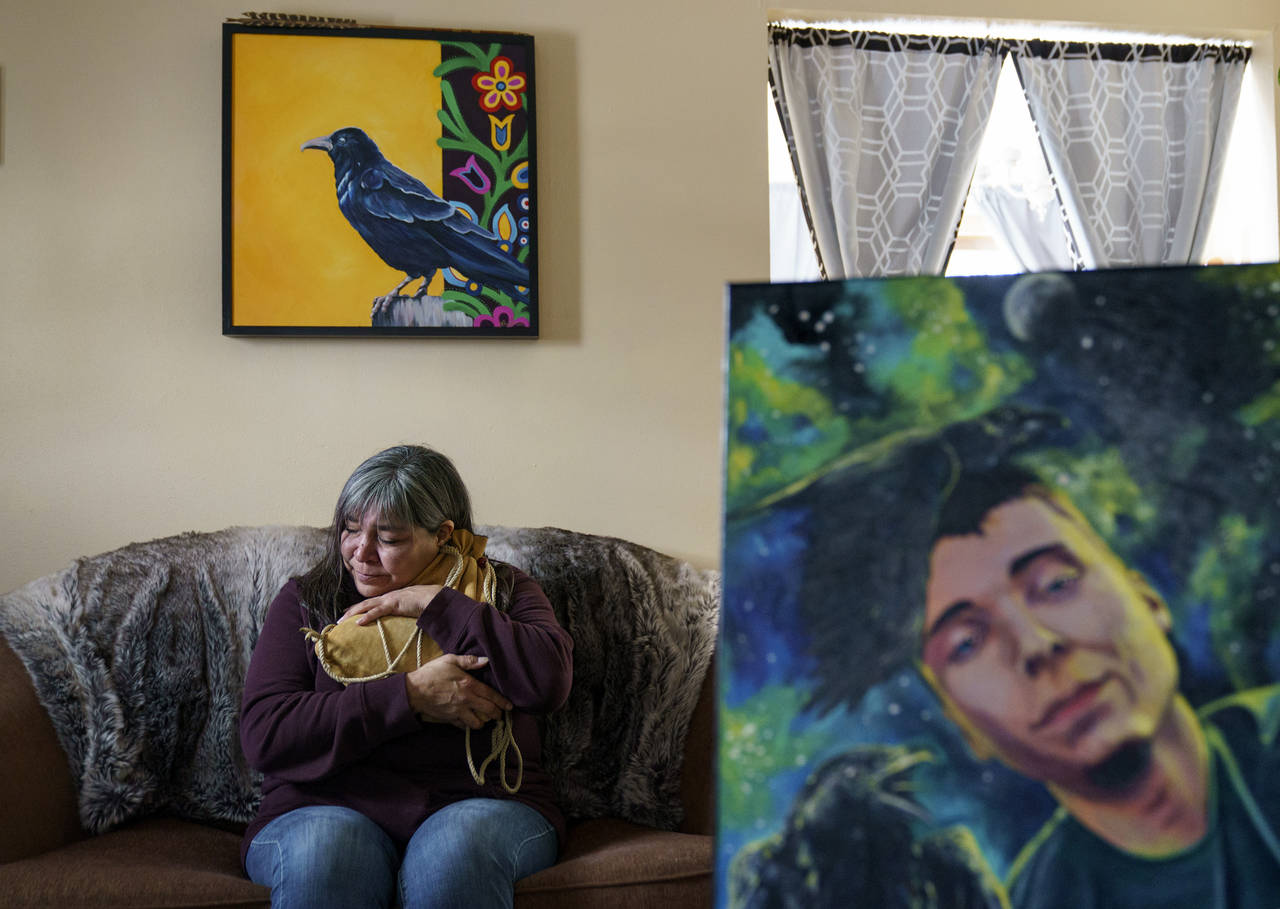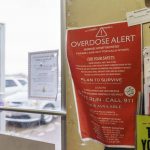As COVID fueled the drug crisis, Native Americans hit worst
Dec 22, 2021, 7:00 PM | Updated: Dec 23, 2021, 10:43 am

Rachel Taylor clutches a buckskin satchel filled with the ashes of her son, Kyle "Little Crow" Domrese, pictured at right, who died of an overdose, as she sits in the home they shared in Bemidji, Minn., Wednesday, Nov. 17, 2021. Just weeks remained until the anniversary of the day she opened his bedroom door and found her son face-down on his bed, one of more than 100,000 Americans lost in a year to overdoses as the COVID-19 pandemic aggravated America's addiction disaster. The death rate from drug overdoses for Native Americans has surpassed white people and is now the highest in the nation. (AP Photo/David Goldman)
(AP Photo/David Goldman)
BEMIDJI, Minn. (AP) — The medicine man told her she should soon give her son back to the earth.
Rachel Taylor kissed her fingertips and pressed them to the crow sewn onto a leather bag nestled on the couch in the living room. “Oh, my baby,” she whispered, and hugged the buckskin satchel filled with his ashes.
Nearly a year ago, she had opened his bedroom door and screamed so loud she woke the neighbor. Kyle Domrese was face down on his bed, one of more than 100,000 Americans lost in a year to overdoses as the COVID-19 pandemic fueled America’s addiction disaster.
When he was 4, the medicine man had given him his Ojibwe name: Aandegoons — “little crow.” She traced the outline of the black bird on the sack.
“Love you,” Taylor said to the bag, as she does each time she leaves for work in this city surrounded by three Ojibwe reservations in remote northern Minnesota.
As the pandemic ravaged the country, deaths from drug overdoses surged by nearly 30%, climbing to a record high. The drug crisis has also diversified from an overwhelmingly white affliction to killing people of color with staggering speed. The death rate last year was highest among Native Americans, for whom COVID-19 piled yet more despair on communities already confronting generations of trauma, poverty, unemployment and underfunded health systems.
It is no longer an opioid epidemic, but one in which people are dying from deadly cocktails of many drugs. Deaths involving methamphetamine have nearly tripled in recent years, with Native Americans 12 times more likely to die from it.
As Taylor began her shift at the Northwest Indian Community Development Center, a posterboard propped against the wall was pasted with 49 faces — a collage of their dead to drugs.
Taylor’s tribe, the White Earth Nation, studied of the lives they’ve lost to addiction.
“Their death certificates say they died of an overdose, but that’s not right,” one member of their study group said.
These deaths were a culmination of far more than that: Despite their resilience, Native Americans carry in their blood 500 years worth of pain from being robbed of their land, their language, their culture, their children. In living people’s memory, children were taken from their families and sent to boarding schools with the motto, “Kill the Indian, save the man.”
“What they died of is a broken heart,” the study says.
For years, Taylor tried to break the cycle.
Her grandmother was sent to a Christian boarding school, where she was taught to be so ashamed of her Ojibwe language that she would only speak or sing it after drinking.
Taylor had her daughter when she was 19 and her son a few years later. She lost custody of them for a couple years as she battled her own addiction to opioids and cocaine. She told them she wished she could fix all the dysfunctional things that happened when she was using.
“Then I thought, well, then my mom would have to go back and fix things, and then my grandma would have to go back, it would have to go on like that for generations,” she said.
Taylor had lived in more than 50 places before she turned 18 — foster homes, battered women’s shelters, on the streets — and faced sexual, physical and mental abuse.
“The things I blame on generational trauma are not feeling good enough, not feeling worthy enough, not feeling loved,” she said.
She prayed to her creator to spare her children, and she told her son every day that she loved him.
White Earth Nation too worked hard to save its people from addiction, and many years lost no one to overdoses on the reservation. But then the pandemic arrived and proved too painful for some.
And now in Taylor’s shaking hands, she holds her son’s picture — another face for the posterboard, lost January 11, 2021.
At first, she put his ashes in an urn, but it was sharp metal. A friend made the buckskin bag that she could hug. It’s become the center of her world.
He’d always loved to laugh, so Taylor teases the bag of ashes.
“Keep an eye on the cat,” she’ll say when she leaves the house. Then she tells the cat to keep an eye on him.
___
The wind churned snow across the prairies, so Dr. Carson Gardner, the medical director of White Earth Nation’s health department, told the tale of the Windigo as a metaphor for addiction.
This story of an evil spirit in Ojibwe folklore can only be spoken with snow on the ground as a layer of protection from the monster. The Windigo is a cannibal that sings a song, and anyone who hears it must cover their ears and run away, he said. Otherwise, they develop an insatiable hunger.
“You will first eat everything in your lodge, and when that’s gone, you’ll eat everything in your neighbors’ lodges. When that’s gone, you will eat your neighbors. You will finish off by eating yourself,” said Gardner.
Their reservation spans more than 800,000 rugged acres of prairie and lakes, dotted with small villages, known for glorious summers and long unforgiving winters. But despite the vast terrain, it’s sparsely populated, and they live the belief that all should be loved like family.
“Those who listen to the Windigo song aren’t bad people,” Gardner said. “They just didn’t plug their ears and walk away. They didn’t know how powerful the song was.”
Rachel Taylor’s son once wrote her a letter because he thought his addiction was killing him: “I can’t control it. I hope you can forgive me. I’m sorry, I love you, I wanted to spend more time with you.”
He’d started abusing pills as a teenager when he got a prescription after having surgery for an infected finger. Then, consumed by the madness of addiction, he would smoke anything — methamphetamine, heroin, fentanyl — that might quiet his lifelong anxiety and depression.
But just before the pandemic bore down, his mother felt hopeful.
She and her son quarantined together at her home in Bemidji, a city of 15,000 people. Her son had gone to treatment, sober 168 days. His cheeks were full again, and he asked her to make his favorite peanut butter cookies.
“I’m glad I still have a chance to make my loving mom proud,” he wrote in a journal.
But the months dragged on, and he told her it seemed like the pandemic would never end. He couldn’t get a job. He was isolated. He said he felt like a bum.
“He just gave up,” she said. He started using again, then dealing drugs to support his habit.
All around them, people were dying. On the White Earth reservation, ambulance calls for overdoses tripled, Gardner said. They posted big red signs in gas stations and tribal buildings: “overdose alert,” they said. “Please look out for each other.”
Joe Kleszyk, the commander of the region’s drug task force, sounded the alarm, too: “An epidemic within a pandemic,” he told the local newspaper in August 2020. The task force covers five counties and two reservations, including White Earth.
The number of overdoses it investigated skyrocketed from 20 in 2019 to 88 last year. Fifteen of those were fatal, triple the year before.
It’s getting worse: This year, there’s been 148 overdoses, and 24 of those victims died.
In Minnesota, as across the country, drug dealers now cut nearly every drug on the street with fentanyl, a cheap and deadly synthetic opioid so potent the equivalent of a sugar packet can make 40 doses, Kleszyk said. “It’s a game of Russian roulette,” he said.
At the same time, the pandemic pushed many toward addiction, called a “disease of despair.”
Unemployment in Indian County surged to 26%. And with the federal government’s disinvestment in Native communities, many were already living on the brink of poverty — sometimes just across the street from predominantly white gated communities and summer vacation resorts.
On top of that, the healing traditions many turn to in troubled times, like sweat lodges and talking circles, were suspended. Theirs is a communal culture, and people were suddenly isolated.
Of the 148 overdoses the task force investigated this year, 124 victims were Native.
“I’m sick of telling people that their kids are dead,” Kleszyk said.
When officers on the White Earth reservation arrived on Aug. 5, 2020 to deliver the news to Betty Oppegard, her knees buckled, and she collapsed to the ground. Her daughter, Beth Renee Hill, a 32-year-old mother of three, died of an overdose involving methamphetamine.
Hill’s Ojibwe name, Bebaanimadookwe, is the word for how snow sparkles in the sunshine.
“She was like that, she sparkled in people’s lives, she was so beautiful,” said Oppegard. “She could make a lot happen in a day.”
Hill started taking methamphetamine a couple years ago and fell apart fast. She lost custody of her kids and despaired, so she did even more drugs.
Oppegard used to wake up each morning and run through the names of her eight children from oldest to youngest, imagining where they were and what they were doing. She forced herself to stop, because when she got to Hill, if felt too much to bear.
For months, Hill’s father just held her picture and cried. Now he’s buried next to her. He died in January, and Oppegard blames a broken heart.
___
Amid all this death and dying, one of the most urgent questions White Earth and other Native American communities are facing is how to spare the next generations from starting the cycle anew.
Indian health care has been underfunded for decades. When the American government forced Native Americans off their land, it signed treaties with tribes promising to provide for them necessities like health care. The dead from addiction is proof it’s never kept its word, said Minnesota Sen. Tina Smith.
The national average for health care spending is just over $11,000 per person, but tribal health systems receive about a third of that and urban Indian groups even less, according to the National Council of Urban Indian Health. COVID-19 added another blow to this already stressed system.
Smith introduced a bill this summer that would usher $200 million in grants to Indian organizations to bolster their mental health and addiction treatment. The bill, still stalled in Congress, would empower Native organizations to address addiction their own way.
In the years before the pandemic, the White Earth tribe married western medical interventions with the traditional healing practices that helped their people survive as the government tried to erase them. They trained thousands how to use the overdose-reversal medication naloxone and estimate that’s saved 1,000 lives, Gardner said. They saved just as many through the millennia of inherited wisdom: drum circles, tobacco ceremonies, the dark, humid honesty of praying in a sweat lodge to balance their bodies, souls and minds.
Their motto is unconditional love, Gardner said. People can recover if they’re given hope and healing, so they don’t give up on anybody, no matter how deep their addiction.
Georgianna Garbow-Warren’s addiction to methamphetamine for years left her homeless — she and her husband lived in abandoned houses, in shelters, eventually under a bridge. She lost custody of her three children. She felt like she was living in circles: She’d use drugs, get her kids taken, clean up, get them back, start the cycle again.
She grew up on the White Earth reservation near Beth Hill. She can rattle off names of other neighbors they’ve lost to addiction.
Garbow-Warren had a fourth child in 2019, a son born premature at four pounds, seven ounces. They took him straight from the hospital.
She kept using meth: “I wanted to take all that pain away,” she said.
Then she couldn’t breathe, went back to the hospital and was diagnosed with congestive heart failure from the damage meth had done. She was in and out of emergency rooms. One day she was lying in bed there and thought: “Oh God, do I really hate myself this much?”
She turned herself into the police on an outstanding warrant, and told them she wanted treatment. It was February 2020, just as the pandemic began brutalizing so many battling addiction.
“This year there’s been the most funerals I’ve been to in my whole life,” she said. Her sister was hospitalized in March with liver and kidney infections from drinking and drug use.
She couldn’t see when Garbow-Warren visited her. The doctors said she could hear them. They played her favorite song by Sir Mix-A-Lot and she wiggled like she was trying to dance. She died a couple days later.
“I’ll never get the image out of my head,” she said. One of her sisters is now in treatment, a brother still uses, and she’s afraid of getting a phone call that he’s dead.
Her husband found recovery, too. They got an apartment, a dog, a car, and slowly regained custody of their baby, who has cerebral palsy. He can’t crawl, and scoots around on his back.
“I blamed myself. I felt a lot of guilt and shame, a lot of pain,” she said, about her son’s medical difficulties. Then a doctor told her there was no way to know if it was from her drug use or something else.
She doesn’t know about her older children. Her son turned 18 this year, the others are 17 and 10. She sometimes imagines tracking them down, but then wonders if they’re better off without her.
“I live with that everyday,” she said, “wondering if they’re OK.”
___
In January, Rachel Taylor’s heart began aching, like someone had reached into her chest and was squeezing it.
“It was like my heart knew before I did,” she said. “My heart was broken four days before he even died.”
She had an uneasy feeling the morning of Jan. 11. It was quiet in the house and her son’s bedroom door was closed.
“Are you awake?” Taylor texted him at 9:21 a.m.
She never wanted to seem overbearing, and she knew it made him happy to think she trusted him. So she vacuumed the living room just outside his bedroom and hoped the commotion would wake him.
Eventually, she opened his door. At first she thought it must be a dream, like she was seeing from outside herself that his skin was purple.
She dialed 911, and the operator said to check his vitals. He was ice cold. She dropped the phone and screamed. “Come back, my baby, come back.”
When he was born, the nurse put him on her chest, and he’d looked at her with such intensity. His eyes were always like that, like a cat’s, she thinks.
He loved animals. In stacks of photos albums, he’s often holding some little creature. She kept everything he ever made her — birthday cards, childhood pottery. “You’re the best mom in the world,” he’d write, and she loved it because she’d always felt like a bad one.
She knew the hell her son was living because she had lived it, too.
In December 2020, he punched holes in the walls until his fists bled and screamed he wanted to die. She called police, and when officers arrived she stepped in front of her bloody, hysterical son. “Please don’t shoot him,” she pleaded, “this isn’t him.”
They took him to a hospital, but he broke a camera, and the hospital kicked him out.
A month later, she watched as they covered him in blue plastic, and begged them to let her kiss his forehead.
The toxicology report said that he’d died of a combination of alprazolam, the drug in Xanax, and fentanyl.
For a time, she didn’t want to live.
Then the medicine man took her to a sweat lodge on the reservation. When she came out, the chatter of two cranes on the wind sounded like a crow — a sign from her son. Now she feeds the crows so they’ll keep coming to the yard.
She still smells him, she said. She swears she hears his particular way of knocking on the door.
The anniversary of his death is approaching on Jan. 11, and it is customary in her culture to return him to nature after a year of grieving, she said.
But every morning, she kisses his bag. Her daughter took her out for a buffet dinner, and the bag went too. She fixed him a plate of his favorite foods, prime rib, mashed potatoes, she buttered him a bun.
“The medicine man says I have to let him go back to the earth,” she said. “But I don’t think I’m going to be able to do that. He left me too soon.”
Copyright © The Associated Press. All rights reserved. This material may not be published, broadcast, rewritten or redistributed.
























